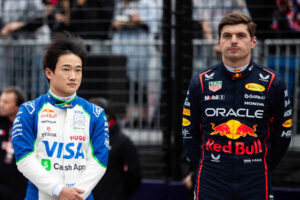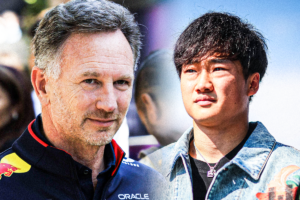BREAKING:Hamilton’s Disqualification Sparks Calls…Read more

Hamilton’s Disqualification Sparks Calls for FIA Rule Changes
Lewis Hamilton’s disqualification from the Chinese Grand Prix has ignited a debate over the FIA’s regulations, with some figures in the sport calling for a reassessment of the rules regarding minor technical infractions.
The seven-time world champion was disqualified after his Mercedes failed post-race inspections. FIA officials found that the plank underneath his car had worn down 0.5mm beyond the allowed limit, violating Article 3.5.9 of the technical regulations. Since the rules specify a minimum thickness of 9mm for the skid block, Hamilton’s car was deemed non-compliant, leading to an automatic disqualification.
The decision has sparked criticism, with former Ferrari driver René Arnoux arguing that the punishment was excessively harsh for such a minor infraction. Speaking to La Gazzetta dello Sport, Arnoux expressed his belief that the FIA should introduce a more lenient approach to technical breaches of this nature.
“I do not believe there was any intent to cheat. If Charles Leclerc’s car had been significantly underweight or if Hamilton’s irregularity had been more extreme, we could have a real discussion about it. But this? We are talking about tiny details that were most likely accidental,” Arnoux stated.
He acknowledged that technical compliance is essential, particularly when it comes to car weight and dimensions, but questioned whether immediate disqualification is always the appropriate response. Arnoux suggested that the FIA introduce a system where minor infractions result in a warning, with penalties only applied if a similar violation occurs again.
“If everything is this complicated, if a matter of mere millimeters can determine race results, and if monitoring every detail is so challenging, then perhaps a range should be introduced,” he added. “A first-time offense should only result in a warning, while a repeat violation would justify a severe penalty. A disqualification has a huge impact, not just on the driver and team, but on the entire championship.”
Hamilton was not the only driver to face disqualification in China. Ferrari’s Charles Leclerc and Alpine’s Pierre Gasly were also removed from the final classification after their cars were found to be underweight. Leclerc’s car was discovered to be 1kg lighter than the minimum requirement, while Gasly’s suffered a similar issue.
This string of disqualifications has led to renewed scrutiny over the strictness of the FIA’s technical regulations. While some argue that maintaining rigid standards is necessary to ensure fairness, others believe that the sport could benefit from a more flexible approach, particularly when infractions are minor and likely unintentional.
The debate over technical regulations and their enforcement is not new in Formula 1. Over the years, teams and drivers have frequently found themselves caught out by stringent rules governing car dimensions, weight distribution, and aerodynamic elements. However, with modern F1 cars being highly complex machines, even small deviations can occur due to track conditions, aggressive driving styles, or unforeseen mechanical wear.
As discussions around the FIA’s stance continue, there is a growing call for a review of how penalties are applied. Whether the governing body will consider making adjustments to its regulatory framework remains to be seen, but Hamilton’s disqualification has certainly reignited the conversation around fairness, consistency, and the need for a more forgiving approach to minor technical breaches in Formula 1.
Lewis Hamilton’s disqualification from the Chinese Grand Prix has ignited a debate over the FIA’s regulations, with some figures in the sport calling for a reassessment of the rules regarding minor technical infractions.
The seven-time world champion was disqualified after his Mercedes failed post-race inspections. FIA officials found that the plank underneath his car had worn down 0.5mm beyond the allowed limit, violating Article 3.5.9 of the technical regulations. Since the rules specify a minimum thickness of 9mm for the skid block, Hamilton’s car was deemed non-compliant, leading to an automatic disqualification.
The decision has sparked criticism, with former Ferrari driver René Arnoux arguing that the punishment was excessively harsh for such a minor infraction. Speaking to La Gazzetta dello Sport, Arnoux expressed his belief that the FIA should introduce a more lenient approach to technical breaches of this nature.
“I do not believe there was any intent to cheat. If Charles Leclerc’s car had been significantly underweight or if Hamilton’s irregularity had been more extreme, we could have a real discussion about it. But this? We are talking about tiny details that were most likely accidental,” Arnoux stated.
He acknowledged that technical compliance is essential, particularly when it comes to car weight and dimensions, but questioned whether immediate disqualification is always the appropriate response. Arnoux suggested that the FIA introduce a system where minor infractions result in a warning, with penalties only applied if a similar violation occurs again.
“If everything is this complicated, if a matter of mere millimeters can determine race results, and if monitoring every detail is so challenging, then perhaps a range should be introduced,” he added. “A first-time offense should only result in a warning, while a repeat violation would justify a severe penalty. A disqualification has a huge impact, not just on the driver and team, but on the entire championship.”
Hamilton was not the only driver to face disqualification in China. Ferrari’s Charles Leclerc and Alpine’s Pierre Gasly were also removed from the final classification after their cars were found to be underweight. Leclerc’s car was discovered to be 1kg lighter than the minimum requirement, while Gasly’s suffered a similar issue.
This string of disqualifications has led to renewed scrutiny over the strictness of the FIA’s technical regulations. While some argue that maintaining rigid standards is necessary to ensure fairness, others believe that the sport could benefit from a more flexible approach, particularly when infractions are minor and likely unintentional.
The debate over technical regulations and their enforcement is not new in Formula 1. Over the years, teams and drivers have frequently found themselves caught out by stringent rules governing car dimensions, weight distribution, and aerodynamic elements. However, with modern F1 cars being highly complex machines, even small deviations can occur due to track conditions, aggressive driving styles, or unforeseen mechanical wear.
As discussions around the FIA’s stance continue, there is a growing call for a review of how penalties are applied. Whether the governing body will consider making adjustments to its regulatory framework remains to be seen, but Hamilton’s disqualification has certainly reignited the conversation around fairness, consistency, and the need for a more forgiving approach to minor technical breaches in Formula 1.








